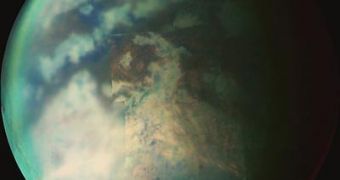Based on data relayed back by the Huygens probe, part of the Cassini-Huygens mission carried out by NASA in collaboration with the European Space Agency, researchers from the University of Granada and the University of Valencia have proven for the first time that the dense atmosphere around Saturn's largest moon, Titan, is able to generate natural electrical activity. The finding has significant scientific importance, since researchers have proven long ago that electric discharges in the atmosphere of our planet can lead to the creation of organic molecules, precursors to life.
Titan was the first moon in the solar system found to have an atmosphere. "On this moon clouds with convective movements are formed and, therefore, static electrical fields and stormy conditions can be produced. This also considerably increases the possibility of organic and prebiotic molecules being formed, according to the theory of the Russian biochemist Alexander I. Oparin and the experiment of Stanley L. Miller," said Juan Antonio Morente of the Department of Applied Physics at the University of Granada. This was also the reason why Titan was a main objective for the Cassini-Huygens mission, he added.
In order to reveal the natural electrical activity in the atmospheres of moons and planets researchers make use of the 'Schumann resonances', a series of spectrum peaks of low frequency in the radio wavelengths, which occur as a result of the presence of a resonant cavity in the layers of the atmosphere located between the ionosphere and the surface. The Schumann resonances consist of three components, the radial electrical field, the tangential magnetic field and the weak tangential field.
The Huygens probe measured the electrical field in the atmosphere with an instrument known as the mutual impedance probe, designed specifically to measure the electrical conductivity of the moon's air. "In a stable fall, without balancing, the MIP would have measured the electrical field's weak tangential component, but fortunately a strong wind balanced the probe and the electrodes measured a superposition of that tangential and radial component," said Morente.
Initial investigations did not find any conclusive evidence of the presence of Schumann resonances in the atmosphere of Titan, but by applying a series of procedures the Spanish team of researchers have finally proven that indeed natural electrical activity exists, although the electromagnetic medium has high losses and the resonant cavity of the atmosphere is somehow less ideal than that of our planet.

 14 DAY TRIAL //
14 DAY TRIAL //